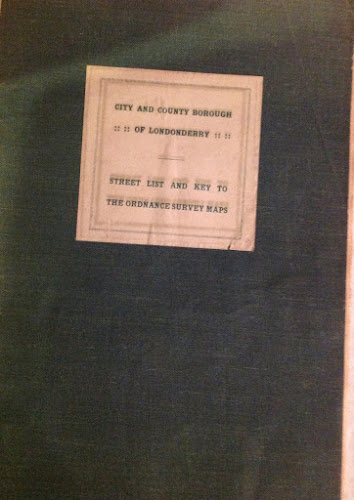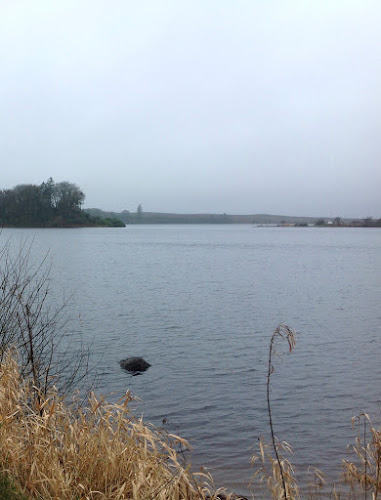I recently came across details of the Deputy Lieutenants for the County of Londonderry going back to 1830. I believe that what I viewed was a copy of a ledger that was kept in what was known as the office of the Clerk of the Crown & Peace at Londonderry Court. The ledger was either held there or possibly at the Town Clerk's office. I don't suppose that many individuals will find this list of interest but I have to concede that I did. Sad I know.
Name. Address. Appointment. Decease
Marquis of Londonderry. Mount Stewart. 1830. March 1834
Lord Garvagh Garvagh. 1833. Lieut of Co 1833
Sir R A Ferguson Bart. The Farm. 1833.VL1837.Lieut1841. 1860
Sir James Bruce Bart. Downhill. 1833 VL 1835. 1836
Henry Barrie Beresfort. Learmount. 1833. 1837
Marcus McCausland. Fruit Hill. 1833. 1869
Henry Richardson. Somerset. 1833. 1849
Wm Lenox Conyngham. Spring Hill. 1833. 1858
Richard Hunter. Jackson Hall. 1833. 1857
Lt. Col. Andrew Knox. Prehen. 1833. 1840
Thomas Scott. Willsborough. 1833. Jan 1872
Geo Hill (afterwards Sir G Hill Bart). St. Columbs. 1833. Dec 15 1845
Lord Stafford. London. 1837. June 3rd 1860
Wm Hamilton Ash. Ashbrook. 1838. Nov 1866
Leslie Alexander. Foyle Park. 1838. 1852
Stewart Crawford Bruce. Coleraine. 1838. Feb 18th 1872
Conolly Gage. Bellarena. 1838. 1843
Alexander Ogilby. Pellipar. 1832. Dec 1837
John Acheson Smith. Ardmore. 1838. 1848
Hugh Lyle. Oaks Lodge. 1839 1845
James Ogilby. Pellipar. 1839. Aug 17th 1885
Nathaniel Alexander. Pt. G ? 1839. Jan 1852
Conolly Skipton. Beech Hill. 1839. March 1854
Robert Bateson. MP Belvoir Park. 1840. 1844
Edmund (Sir E McNaughten Bart). Roe Park. 1840. 187?
John Barrie Beresford. Learmount. 1841 (VL 1867)
Sir H Henry Bruce Bart. Downhill. 1841 ( Lt 1871). Dec 8th ?
Thos (afterwards Sir T Bateson Bart). Belvoir Park
George Knox. Prehen. 1848. 1848
Conolly Lecky. Pump St. Derry 1848. July 17th 185?
Acheson Lyle. The Oaks. DL 1848 Lt 1861. April 22nd 18?
Rowley Miller. Moneymore. 1848. 1866
Robert Paul Dawson. Mohola Park. DL 1849 Lt 1870. Sept 1877
John Stevenson. Fortwilliam. 1849. 1856
John Cromie. Cromore. 1852. Jan 187?
Lord Garvagh. Garvagh. 1853 1871
Sir F. W. Heygate Bart MP. Bellarena. 1854. Nov 14th 18.
John Boyd MP. Coleraine. 1855. 1862
Sir Robt Bateson Bart. Belvoir Park. 1856. 1863
Robert Leslie Ogilby. Ardnangle. 1857. 1872
Sir Robert Bateson Bart. Cas? 1858. April 1872
Wm Lenox Conyngham. Spring Hill. 1858. 1908
James Johnston Clarke. La? 1859. June 1871
Samuel Maxwell Alexander. Roe Park. 1861. June 1886
Thos Richardson. Somerset. 1861. April 1868
George Skipton. Beech Hill. 1864. 1877
Conolly Thos McCausland. Drenagh. 1864. June 1902
Major George Browne. Cumber House. 1867. 1887
Captain Mintgomery. Benvarden. 1867. Resigned 1877
James Acheson Lyle. The Oaks. 1867. 1907
Robert Holbeche Dolling. Manor House Kilrea. 1868. Sept 1878
Sir John Hill Bart. St. Columbs. 1870. July 1872
John Adams. Ballydevitt 1870. Oct 1877
Hon Robert O'Neill. Derrynoyd. 1871. August 1910
Col Geo Knox. Prehen. 1872. Nov 1910
Major William Scott. Willsborough. 1872. March 1913
Hon Albert Canning. Garvagh. 1872.
Robert J Alexander. Portglenone. 1875. Resigned
Major A. Spencer Chichester. Moyola Park. 1877. 1901
Rt. Hon Sir Samuel Martin. Myroe. 1877. 1883
Henry Kyle. Laurel Hill. 1877. April 1878
Lt. Col. Stewart Bruce. Ballyscullion. 1877. 1909
Robert Lyon Moore. Molenan. 1878. June 1902
Captain Butler M. Giveen (?). Cooldaragh. 1878. June 5th 1891
J. A. W. Torrens. Somerset. 1898 (V. Lt. 1909)
Col. St. J. L. Bruce. Downhill. 1883. May 8th 1919
Captain Robert Ogilby. Pellipar. 1885. 1902
William Tillie. Duncreggan House. 1886. March 1904
Hugh Lyle Knocklarna. Sept 1888
W. L. H Brown RM. Comber. 12 th March 1891. 1901
W. R. H. Beresford RWF. Ashbrook. 10th August 1891. 1901
Sir F. G. Heygate Bart. Bellarena. 12th December 1894
Col. J J Clark (Ld Lieut 1915). Larganbogher. December 12th 1894. 1926
Wm. W. F. Bigger. Riverview. November 1895. 1901

















































